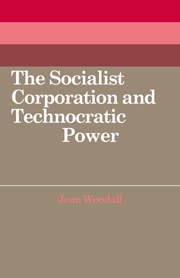 The Socialist Corporation and Technocratic Power
The Socialist Corporation and Technocratic Power Published online by Cambridge University Press: 07 October 2011
We have already referred to the analysis of Polish economic reforms made by Zieliński, who attributed it to the contradictory objectives of planners (with consequent eclecticism) and a false policy of transition (with associated mistiming). This chapter will try to illustrate these features and relate them to overall problems of Polish economic development since 1945. At the same time the author is not satisfied by a purely economic explanation, and will argue that post-war industrial growth is determined and constrained by political factors, both domestic and international, and by pre-war social structure and forms of property ownership. It is felt that there was no inevitable economic logic that led to the creation of a command model of planning and management after 1948, and that the structure of ownership and employment in agriculture is of crucial importance to comprehending the success of industrial growth strategy. The weight of history lies heavy on the Polish economy even today. Problems of the 1940s and 1950s were still to be resolved in the Fifth Five-Year Plan 1976–80. Rather than present a chronology of the medium-term plans, the period since 1945 will be treated in four sections: the capitalist heritage, the transition to a planned economy, the economic experimentation and reform 1956–70, and post-1970 prosperity. It is hoped that through this the reader will be provided with an understanding of the reasons why planners turned their attention to modifications of the structure of the enterprise along the lines of merger and concentration.
To save this book to your Kindle, first ensure [email protected] is added to your Approved Personal Document E-mail List under your Personal Document Settings on the Manage Your Content and Devices page of your Amazon account. Then enter the ‘name’ part of your Kindle email address below. Find out more about saving to your Kindle.
Note you can select to save to either the @free.kindle.com or @kindle.com variations. ‘@free.kindle.com’ emails are free but can only be saved to your device when it is connected to wi-fi. ‘@kindle.com’ emails can be delivered even when you are not connected to wi-fi, but note that service fees apply.
Find out more about the Kindle Personal Document Service.
To save content items to your account, please confirm that you agree to abide by our usage policies. If this is the first time you use this feature, you will be asked to authorise Cambridge Core to connect with your account. Find out more about saving content to Dropbox.
To save content items to your account, please confirm that you agree to abide by our usage policies. If this is the first time you use this feature, you will be asked to authorise Cambridge Core to connect with your account. Find out more about saving content to Google Drive.